
A roller coaster is a type of amusement ride employing a form of elevated railroad track that carries passengers on a train through tight turns, steep slopes, and other elements usually designed to produce a thrilling experience. Trains consist of open cars connected in a single line, and the rides are often found in theme parks around the world. Roller coasters first appeared in the 17th century, and LaMarcus Adna Thompson obtained one of the first known patents for a roller coaster design in 1885, based on the Switchback Railway which opened a year earlier at Coney Island.

Kennywood is an amusement park in West Mifflin, Pennsylvania, just southeast of Pittsburgh. The park opened on May 30, 1898, as a trolley park attraction at the end of the Mellon family's Monongahela Street Railway.
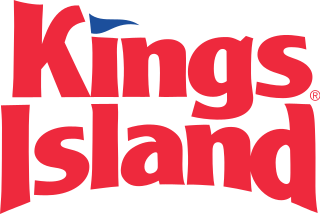
Kings Island is a 364-acre (147 ha) amusement park located 24 miles (39 km) northeast of Cincinnati in Mason, Ohio, United States. Owned and operated by Six Flags, the park was built by Taft Broadcasting and opened in 1972. It was part of a larger effort to move and expand Coney Island, a popular resort destination along the banks of the Ohio River that was prone to frequent flooding. After more than $300 million in capital investments over the years, the park has grown to feature over a hundred attractions including fifteen roller coasters and a 33-acre (13 ha) water park.

Knoebels Amusement Resort is a family-owned and operated amusement park, picnic grove, and campground in Elysburg, Pennsylvania. Opened in 1926, it is the United States's largest free-admission park. The park has more than 60 rides including three wooden roller coasters, three steel roller coasters, a 1913 carousel, and two haunted house dark rides.
A steel roller coaster is a type of roller coaster classified by its steel track, which consists of long steel tubes that are run in pairs, supported by larger steel columns or beams. Trains running along the track typically rely on wheels made of polyurethane or nylon to keep each train car anchored to the track. The introduction of tubular steel drastically changed roller coaster innovation, allowing for greater speeds, higher drops, and more intense elements such as inversions.
Anton Schwarzkopf was a German engineer who founded Schwarzkopf Industries GmbH, a German manufacturer of roller coasters and other amusement rides that were sold to amusement parks and travelling funfairs around the world.
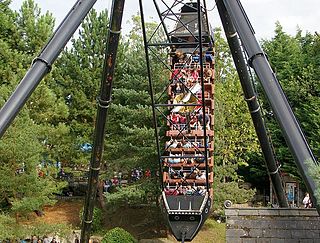
A pirate ship is a type of amusement ride based on pirate ships, consisting of an open, seated gondola which swings back and forth, subjecting the rider to various levels of angular momentum. A variant where the riders must pull on ropes to swing the ride is known as a swing boat.

Arrow Dynamics was an American manufacturing and engineering company that specialized in designing and building amusement park rides, especially roller coasters. Based in Clearfield, Utah, the company was the successor to Arrow Development (1946–1981) and Arrow Huss (1981–1986), which were responsible for several influential advancements in the amusement and theme park industries. Among the most significant was tubular steel track, which provided a smoother ride than the railroad style rails commonly used prior to the 1960s on wooden roller coasters. The Matterhorn Bobsleds at Disneyland, built in 1959, was Arrow's first roller coaster project.
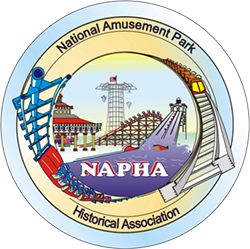
The National Amusement Park Historical Association (NAPHA) is an international organization dedicated to the preservation and enjoyment of the amusement and theme park industry – past, present and future.
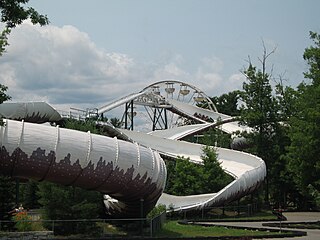
Alpine Bobsled was a steel bobsled roller coaster at the Six Flags Great Escape and Hurricane Harbor amusement park in Queensbury, New York. Manufactured by Intamin, the coaster first opened to the public in 1984 at Six Flags Great Adventure. It was later relocated to Six Flags Great America in 1989, then to Six Flags Great Escape in 1998. Alpine Bobsled closed permanently on September 4, 2023, to make room for The Bobcat.

Phantom's Revenge is a steel hypercoaster located at Kennywood amusement park in West Mifflin, Pennsylvania. It originally opened as Steel Phantom in 1991, featuring the fastest speed and longest drop of any roller coaster in the world. Its second drop is longer than its first, which is a unique characteristic among roller coasters. Manufactured by Arrow Dynamics, the ride was later modified and renovated by D. H. Morgan Manufacturing for the 2001 season when it reopened as Phantom's Revenge. The drop and track length were both increased, and its four inversions were removed, allowing for the removal of its uncomfortable over-the-shoulder restraints.

The Whip was a ride originally designed and built by W.F. Mangels Company of Coney Island, New York, United States. William F. Mangels patented the ride in 1914 and it soon became extremely popular.
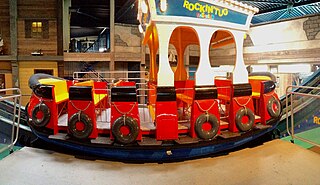
Rockin' Tug is a flat tugboat ride manufactured by Zamperla. The ride is manufactured in both traveling and park versions. It is the first of a line of new "halfpiperides". Zamperla's Disk'O is another popular ride from that "family". The difference is that the Rockin' Tug has a friction wheel, while the Disk'O is powered driven.

Gerstlauer Amusement Rides GmbH is a German manufacturer of stationary and transportable amusement rides and roller coasters, located in Münsterhausen, Germany. As of May 2024, all 113 Gerstlauer-made rollercoasters are still in operation and at their original park, apart from Seifenkiste at Trampolino Familien- und Freizeitpark, which is currently in storage, and Pandemonium at Six Flags Discovery Kingdom, which now operates at Six Flags Mexico under the name of Joker.
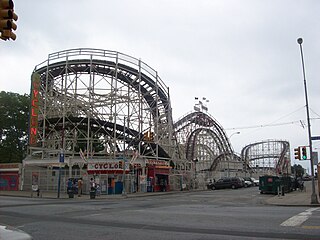
Roller coaster amusement rides have origins back to ice slides constructed in 18th-century Russia. Early technology featured sleds or wheeled carts that were sent down hills of snow reinforced by wooden supports. The technology evolved in the 19th century to feature railroad track using wheeled cars that were securely locked to the track. Newer innovations emerged in the early 20th century with side friction and underfriction technologies to allow for greater speeds and sharper turns. By the mid-to-late 20th century, these elements intensified with the introduction of steel roller coaster designs and the ability to invert riders.

Avalanche is a steel bobsled roller coaster at Pleasure Beach Resort in Blackpool, England. It is the first and, as of 2022, the only bobsled roller coaster in the United Kingdom. It was designed for the park by Mack of Germany in 1988.

Steel Curtain is a steel hypercoaster at Kennywood in West Mifflin, Pennsylvania, United States. Manufactured by S&S – Sansei Technologies, the coaster reaches a height of 220 feet (67 m) and features either eight or nine inversions, including a 197-foot (60 m) corkscrew considered to be the world's tallest inversion. Themed to the Pittsburgh Steelers NFL football team, the roller coaster is named after the Steel Curtain, the nickname for the Steelers' defensive line during the 1970s.



















